Sauna Stress Relief: How to Use a Sauna for Natural Anxiety Treatment
Stress, anxiety, and associated mental health disorders are increasingly pervasive issues across modern societies. Recent survey results reveal nearly 20% of adults in the United States, or over 40 million people, live with anxiety disorders currently, with around 32% reporting frequent anxiety and depression symptoms. These conditions not only severely impact the quality of life but also can lead to other long-term chronic diseases.
Sauna use is an easy, all-natural way to reduce anxiety. Extensive research demonstrates sauna therapy produces potential significant physiological and psychological stress reduction.
In this comprehensive guide, you’ll learn:
-
The scientific backing on how saunas tangibly lower anxiety and tension
-
The different types of home saunas available for stress and anxiety relief
-
Specific protocols for using sauna sessions to promote relaxation and peace of mind
-
Additional lifestyle tips that complement sauna use for holistic anxiety treatment
Read on to see why even ancient civilizations were onto something by making sweat lodges central to their cultures!

The Proven Scientific Benefits of Sauna for Stress Relief
Extensive medical research over the past few decades demonstrates saunas can potentially alleviate markers of psychological stress. The results include lowering stress, lowering blood pressure, reducing inflammation, normalizing hormones like cortisol, and increasing positive neurotransmitters.
Regular sauna bathing produces what’s known as “heat stress” or “whole body hyperthermia conditioning” in the body. Heat stress from saunas triggers intricate physiological responses - including improved cardiovascular function, decreased inflammation, and boosted mood-regulating chemicals.
Let’s explore the science of exactly how sauna use relieves stress and chronic anxiety at a biological level:
How Sauna Therapy Releases “Feel Good” Hormones and Chemicals
Sitting in a hot sauna heat can trigger your sympathetic nervous system, part of your body’s innate “fight or flight response.” The natural response of the autonomic nervous system is designed to take us away from dangerous conditions. The process leads to a surge of euphoric hormones and chemicals like endorphins, dopamine, and oxytocin.
Endorphins function as the body’s natural opiates - blocking feelings of chronic pain and discomfort while producing pleasant sensations. One study found a 30-minute sauna session increased beta-endorphin levels on average. Dopamine boosts motivation, pleasure, and attention - alleviating common anxiety symptoms like restlessness and worry.
Oxytocin is best known as the “love” or social bonding hormone. Sauna-induced oxytocin release promotes feelings of calmness, well-being, and optimism.
The Cardiovascular Benefits of Regular Sauna Use
The high heart rate and improved circulation you experience in the sauna provide cardiovascular training effects with regular use. Using saunas frequently conditions your blood vessels and vascular function - leading to healthier blood circulation over time.
Studies demonstrate sauna bathers have lower risk of hypertension and high blood pressure compared to non-bathers. Reduced blood pressure and cardiovascular load directly correspond to lower daily stress and anxiety levels.
Using Different Types of Saunas for Stress Relief
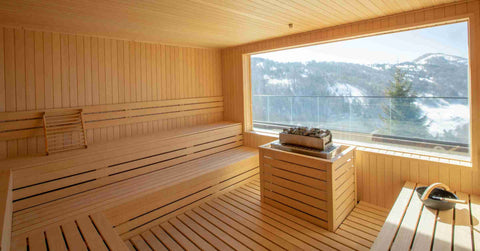
Saunas are a popular way to relax, detoxify, and alleviate stress. Various types of saunas offer unique experiences and potential mental health benefits, including stress relief. Understanding the differences can help you choose the right sauna to incorporate into your stress management routine.
Traditional Finnish Saunas
The traditional Finnish sauna is a high-heat, low-humidity environment, typically ranging from 150°F to 195°F (65°C to 90°C). Wood-burning or electric heaters are used to heat the room and sauna rocks. Water can be thrown onto the hot stones to produce a burst of steam, increasing humidity momentarily.
Stress Relief Benefits:
-
The intense heat exposure of a Finnish sauna encourages deep muscle relaxation, easing physical tension and stress.
-
The ritual of alternating between the hot sauna and a cool shower or plunge can enhance relaxation and invigorate the senses. A traditional sauna promotes a sense of well-being.
-
The seclusion and quietness of the dry sauna environment provide a meditative space to unwind mentally.
Infrared Sauna
Infrared saunas use infrared heaters to emit infrared light. The infrared heat is absorbed directly by the skin's surface, heating the human body from the inside out. The infrared sauna sessions operate at lower temperatures, usually between 120°F to 150°F (49°C to 65°C), making them more tolerable for some individuals.
Stress Relief Benefits:
-
The gentle heat of an infrared sauna session penetrates deep into the muscles, providing relief and relaxation without the intense heat of traditional saunas.
-
Infrared saunas can promote better sleep patterns and relaxation, helping to reduce stress levels over time.
-
The lower temperatures of infrared sauna treatment can be more comfortable for longer sauna sessions, allowing for extended periods of meditation and relaxation.
Near-Infrared Saunas
Near-infrared (NIR) saunas use a light spectrum that is closest to visible light, with wavelengths that are believed to promote skin renewal, cell health, and tissue growth.
Stress Relief Benefits:
-
NIR saunas can help improve circulation and promote healing, which may indirectly contribute to stress relief by enhancing overall well-being.
-
Light exposure can stimulate serotonin production, potentially improving mood and reducing feelings of stress.
Far-Infrared Saunas
Far-infrared (FIR) saunas use wavelengths longer than NIR, which penetrate deeper into the body's tissues, promoting detoxification and deep muscle relaxation.
Stress Relief Benefits:
-
FIR saunas are particularly effective in warming the body directly, promoting deep relaxation of muscles, and reducing tension, which can alleviate stress.
-
The deep penetrating heat can also improve sleep patterns, further aiding in stress reduction and relaxation.
Full-Spectrum Infrared Saunas
Full-spectrum infrared saunas combine NIR, mid-infrared (MIR), and FIR wavelengths, offering a comprehensive range of benefits from the entire infrared spectrum.
Stress Relief Benefits:
-
Full-spectrum saunas provide the combined benefits of NIR, MIR, and FIR, making them highly effective for stress relief through muscle relaxation, improved circulation, and detoxification.
-
The versatility of full-spectrum saunas allows users to customize their experience based on specific stress relief and relaxation needs, potentially enhancing the overall effectiveness of the sauna session.
Steam Rooms
Though not saunas in the traditional sense, steam rooms are often grouped in the same category due to their use for similar purposes. Steam rooms provide a high-humidity environment with the average sauna temperature typically between 100°F and 120°F (38°C to 49°C).
Stress Relief Benefits:
The moist heat of a steam room can help clear the sinuses and respiratory passages, which can be soothing and relaxing, especially for those with respiratory issues.
The warmth and humidity can also help to soothe and relax muscles, reducing physical stress and tension.
The sensation of being enveloped in warm steam can create a cocoon-like experience, aiding in mental well being, relaxation, and stress reduction.
Wood-Burning Saunas
Wood-burning saunas offer a more traditional and rustic sauna experience, using a wood stove to heat the sauna room and stones. These saunas are known for their soft heat and the pleasant aroma of burning wood, which can enhance the relaxation experience.
Stress Relief Benefits:
-
The natural ambiance and crackling sound of the wood fire can provide a soothing and grounding experience, helping to alleviate stress.
-
The heat from a wood-burning sauna is often perceived as softer and more enveloping, promoting deep muscle relaxation and stress relief.
-
The ritual of tending to the fire and the connection to nature can be meditative and stress-reducing in itself.
When choosing a sauna for stress relief, consider your personal preferences, health conditions, and the specific benefits you're seeking. Whether you prefer the intense heat of a traditional Finnish sauna, the gentle warmth of an infrared sauna treatment, the moist heat of a steam room, or the rustic experience of a wood-burning sauna, each offers a unique way for prolonged therapeutic benefit.
RELATED TO: Sauna for Depression Relief: How Heat Therapy Can Improve Your Mood
Using Sauna Therapy for Natural Anxiety Treatment and Mental Health Benefits
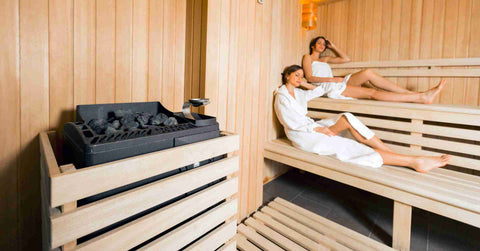
Carefully designing your sauna sessions can promote maximum anxiety relief beyond general stress reduction. Follow these tips on preparing your sauna space, along with recommended usage guidelines targeting anxiety symptoms:
Preparing Your Sauna Space for Maximum Relaxation
Set yourself up for successful anxiety relief by carefully preparing your sauna environment. Maintain a slightly lower 150°F temperature for comfort and place towels or cushions for comfort.
Play calm, meditative music and keep the lighting dim for an ambiance encouraging mental quieting. You can also place a few drops of anxiety-reducing essential oils like lavender or chamomile nearby to enhance the relaxation response through aromatherapy.
Integrating Mindfulness Practices for Sauna Anxiety Relief
Complement your sauna session by actively practicing mindfulness techniques during heat therapy. Focus on taking full, deep breaths using your diaphragm. Let anxious thoughts pass through your mind without judgment or reaction.
You can also visualize your tension and stress washing away with each bead of sweat. Repeat mantras encouraging positivity and relaxation. The physical act of typical sauna bathing habits primes you for mental stillness.
Sauna Therapy Session Guidelines for Anxiety Relief
For anxiety, aim for shorter 10-20 minute sauna sessions, then build tolerance over time. Track your mood before and after - most feel an immediate difference as worries dissipate. Hydrate well and cool off for at least 5-10 minutes between rounds.
As you acclimate, try to work up to 20-40 minutes of daily sauna sessions. Sauna therapy for anxiety only requires 3-4 days a week to make a significant difference long-term by lowering cortisol, raising endorphins, and reducing inflammation.
Lifestyle Tips to Complement Sauna Use for Natural Stress Relief
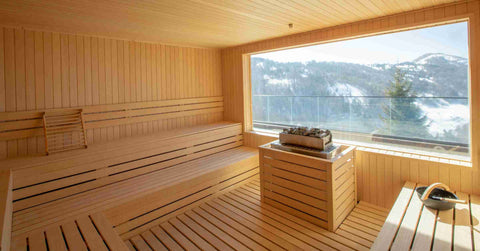
While targeted sauna therapy is hugely beneficial for anxiety relief, integrating other positive lifestyle factors will compound the effects. Treat sauna use as one piece of an overall stress reduction program.
Exercise, Nutrition and Improved Sleep Hygiene
Make sure to continue regular cardio and strength training, even on non-sauna days. This schedule maintains healthy circulation while burning cortisol and boosting mood-enhancing endorphins.
Eat a nutrient-dense, Mediterranean-style diet full of antioxidants to lower systemic inflammation alongside sauna detoxification. Prioritize sufficient high-quality sleep every night to allow hormones to normalize.
Relaxation Techniques, Nature Exposure, and Social Connection
Complement saunas with yoga, meditation, creative hobbies, or music immersion to fill your week with relaxing activities. Spend more time outdoors walking or reading to destress.
Don’t isolate yourself if you are struggling with anxiety. Make sure to arrange regular in-person social events to benefit from oxytocin boosts through human connection. Opening up can help prevent repetitive negative thought patterns as well.
The combination of induced heat stress, mindfulness practices, balanced nutrition, physical activity, and social bonding works powerfully to alleviate anxiety without medications.
Maximizing Sauna Stress Relief Benefits

To fully reap the potential benefits of sauna therapy in combating stress and anxiety, it's imperative to approach it as part of a broader wellness strategy. This section delves into methods to enhance the calming effects of your sauna experience and integrate it seamlessly into your life.
Combining Sauna Sessions with Complementary Stress-Relief Practices
Meditation and Mindfulness: Engage in meditation or mindfulness exercises while in the sauna. The quiet, warm environment can enhance your focus and deepen the relaxation effects.
Yoga or Gentle Stretching: Before or after your sauna visit, consider doing gentle at home yoga poses or stretches. Yoga can improve flexibility, reduce muscle tension, and promote an overall sense of well-being.
Hydration with Herbal Teas: Staying hydrated is key in sauna use. Choose herbal teas like chamomile or peppermint before or after your session to enhance relaxation and hydration.
Lifestyle Adjustments to Enhance Sauna Benefits
Regular Sleep Patterns: Aim for consistent sleep schedules. A well-rested body responds better to stress relief practices, including sauna sessions.
Balanced Diet: Incorporate stress-reducing foods into your diet, such as leafy greens, nuts, and seeds, which can complement the detoxifying effects of sauna use.
Digital Detox: Reduce screen time, especially before bed and during relaxation periods. A digital detox can help lower stress levels and make sauna visits more effective.
Sauna Use Frequency for Ongoing Anxiety Management
Begin with Moderation: Start with 1-2 sauna sessions per week, gradually increasing frequency as your body adjusts.
Listen to Your Body: Pay attention to how your body and mind respond to sauna therapy. Some may benefit from daily sessions, while others may find 2-3 times per week sufficient.
Consult with Professionals: If you're using sauna therapy specifically for stress and anxiety relief, consider consulting with a wellness professional to tailor the best schedule for your needs.
Safety Considerations and Best Practices
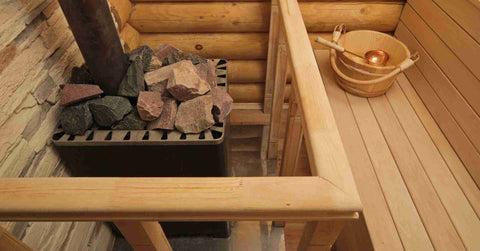
While sauna therapy is a beneficial stress relief tool for many, it's essential to approach it with mindfulness towards safety to ensure a positive and healthful experience.
Key Safety Tips for Sauna Use
Stay Hydrated: The high temperatures can lead to sweating and dehydration. Drink plenty of water before, during, and after your sauna session.
Monitor Time Spent in Sauna: Limit sessions to 15-20 minutes at a time, especially for beginners, to prevent overheating and dehydration.
Avoid Alcohol: Never use a sauna under the influence of alcohol as it increases the risk of dehydration, hypotension, and heat stroke.
Health Contraindications
Certain individuals should exercise caution or avoid sauna use altogether to avoid adverse health outcomes, including:
Pregnant Women: Those who are pregnant should consult with a healthcare provider before using a sauna due to the risk of overheating.
Individuals with Cardiovascular Conditions: People with cardiovascular system illnesses like heart conditions should seek medical advice prior to sauna use as heat can affect heart rate and blood pressure.
Those with Skin Conditions: Individuals with certain skin conditions may experience worsening symptoms due to the dry heat or sweating.
Gradually Introducing Sauna Sessions
Start Slowly: Begin with lower temperatures and shorter durations, gradually increasing as your tolerance builds.
Cool Down Gradually: After exiting the sauna, allow your body to cool down naturally before taking a cold shower to avoid shocking your system.
Observe Body Reactions: Pay attention to how your body reacts during and after sauna sessions. Any signs of discomfort or adverse reactions should be taken seriously, and sauna use should be adjusted or discontinued accordingly.
Frequently Asked Questions About Sauna Use and Sauna for Stress Relief
How does sauna use help reduce stress and anxiety?
Sauna use promotes relaxation and stress relief through several mechanisms. The heat from the sauna helps to relax muscles, ease tension, and reduce physical pain, which can contribute to mental relaxation. The warmth stimulates the release of endorphins, the body's natural feel-good chemicals, which can improve mood and pain relief and create a sense of well-being. Also, the quiet, meditative environment of a sauna can provide a peaceful retreat from the stresses of daily life, allowing for mental relaxation and mindfulness.
How often should I use the sauna for stress relief?
The optimal frequency of sauna use varies from person to person, depending on individual health, lifestyle, and how one's body responds to heat therapy. Starting with 1-2 sessions per week and observing your body's reaction is a good approach. Some may find daily sessions beneficial, while others may prefer 2-3 times per week. It's important to listen to your body and adjust accordingly, and consult a healthcare professional if unsure.
What is the ideal temperature and duration for a stress-relief sauna session?
The ideal temperature for a sauna session generally ranges from 150°F to 195°F (65°C to 90°C). For stress relief, sessions should last between 15 to 20 minutes. Beginners should start with lower temperatures and shorter durations, gradually increasing as they become accustomed to the heat. It's imperative to exit the sauna if you feel dizzy, uncomfortable, or overly chronic fatigued at any point.
Can sauna use have a long-term effect on stress and anxiety levels?
Regular sauna use can contribute to long-term reductions in stress and anxiety levels by promoting relaxation, improving sleep patterns, and enhancing overall well-being. The cumulative effect of repeated relaxation responses during sauna sessions can help in managing stress levels over time. However, it's most effective when combined with other stress management techniques and a healthy lifestyle.
Are there any risks associated with using a sauna for stress relief?
While sauna use is safe for most people, there are risks if safety guidelines are not followed. Dehydration, overheating, and heat stroke are potential risks, especially if one stays in the sauna too long or does not drink enough water. Individuals with certain health conditions, such as cardiovascular diseases, low blood pressure, or pregnant women, should consult a healthcare provider before using a sauna.
Can I use the sauna if I have high blood pressure?
Individuals with high blood pressure should consult with their healthcare provider before using a sauna. While some studies suggest that regular sauna use may help improve blood flow over time, it's important to approach sauna use cautiously and under medical advice, especially if blood pressure is not well-controlled or if one is on medication.
Is it better to use a sauna before or after exercise for stress relief?
Using a sauna after exercise can be particularly beneficial for stress relief. The heat helps to relax and soothe muscles that have been worked during physical activity, aiding in recovery and enhancing the relaxation effect. However, some may prefer a sauna session before exercise as a way to warm up muscles and increase flexibility. Personal preference and how your body responds will guide the best timing for you.
Should I drink water before or after using the sauna?
It's important to hydrate both before and after using a sauna. Drinking water before entering the sauna helps to prevent dehydration, and replenishing fluids after the session is imperative to replace the water lost through sweating. Avoiding alcohol and caffeine, which can dehydrate the body, is also recommended when planning sauna sessions.
Can sauna use improve sleep quality?
Yes, sauna use can improve sleep quality and aid in sleep disorders. The relaxation and stress relief provided by sauna sessions can make it easier to fall asleep and contribute to more restful sleep. The drop in core body temperature after leaving the sauna can also signal the body that it's time to sleep, further aiding in sleep quality.
Are infrared saunas as effective as traditional saunas for stress relief?
Both infrared and traditional saunas can be effective for stress relief, though they work differently. Infrared sauna therapy uses infrared light to create heat, which penetrates more deeply into the tissues at lower temperatures, potentially offering relaxation and stress relief without the intense heat of traditional saunas. Some users prefer infrared saunas for comfort reasons, while others find the intense heat of traditional saunas more beneficial. Personal preference and how one's body reacts to each type of sauna will determine which is more effective for stress relief.
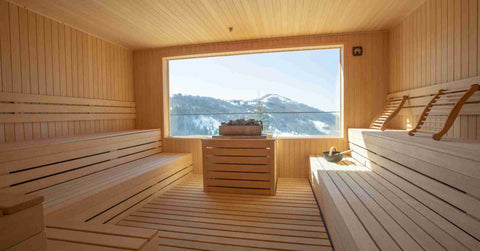
In Summary
Sauna sessions produce potential biological and psychological effects that alleviate mental and physical stress - from lowering blood pressure to releasing mood-elevating endorphins. Studies demonstrate consistent sauna users less likely to be at risk for depression and anxiety disorders.
Yet sauna therapy represents just one piece of a lifestyle approach targeting anxiety relief. Regular exercise, sufficient sleep, a nutritious diet, and purposeful relaxation practices complement heat stress for real, sustainable change.
The good news is nearly everyone can use saunas safely. Whether you currently struggle with pronounced anxiety or general high-stress levels, developing a frequent sauna bathing ritual serves as a core anchor habit supporting improved quality of life.
Commit to your own heat therapy program 2-4 times a week based on the latest clinical evidence behind saunas for mental health presented here. With continued use, many people find they are able to manage daily stressors and triggers with significantly more ease. They often feel a deeper sense of well-being not quickly achieved through any other method.
So turn down the lights, put on some calming music, and step into the age-old practice of sauna therapy for rebalancing your mind today.
